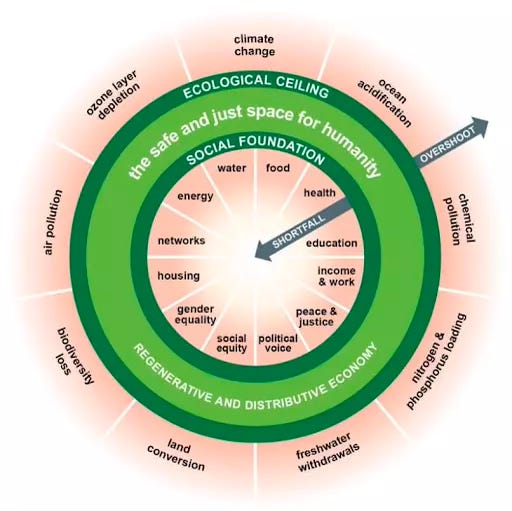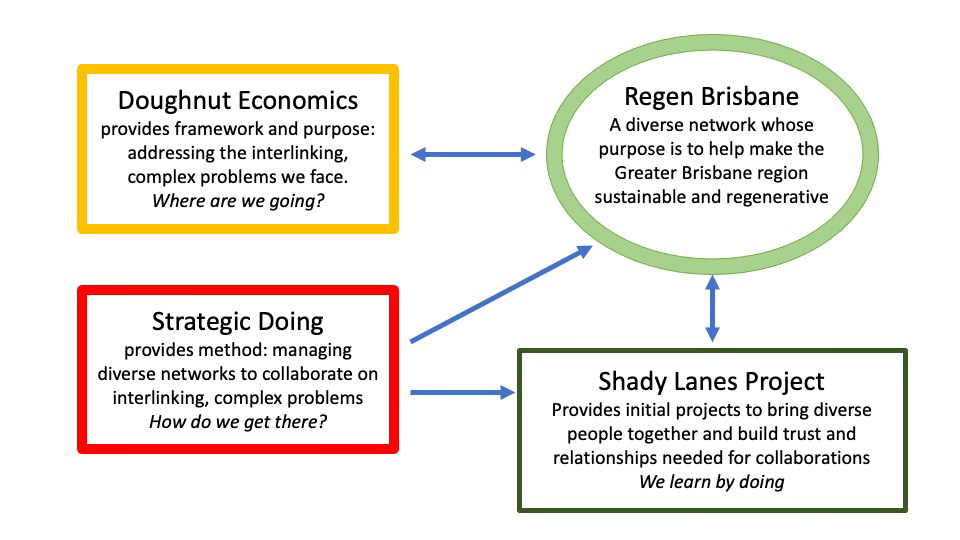Where are we going and how do we get there?
Doughnut Economics and Strategic Doing help us work out the answers to these questions.
The thing that draws me to Doughnut Economics is that it forces us to look at the interlinked nature of the climate crisis. We need to stay within planetary boundaries while trying to address the multiple Sustainable Development Goals.
Doughnut Economics provides a framework for us to imagine what a sustainable, regenerative future might look like. It helps us find a common purpose. It sets the boundaries of where we are going.
So, our environmental solution must also consider social and economic aspects. Our economic (circular economy) solution must also consider environmental and social aspects. And so on. We can’t solve complex problems with linear solutions.
None of us have the knowledge or resources to solve complex problems alone. No sector, no discipline, no organisation. Collaborations are the key - cross-sector, cross-discipline collaborations. That can only come out of diverse networks, and networks of networks.
Making it local and relatable
In November, I gave a presentation at my local ACF Brisbane Northside group about Doughnut Economics and asked how we might apply it to ourselves and our local region.
How do we get there?
Managing complex networks and collaborations is very different to the hierarchical ways to manage projects with aligned teams and partnerships.
On one hand, a collaboration can be like the proverbial herding of cats with people pulling in many different directions. On the other, it’s the frustration of trying to turn broad agreement and support into effective and ongoing action.
Turning our ideas from talking into action is a constant challenge for change-making projects. We can easily get trapped into preaching to the choir while being ignored by everyone else.
Strategic Doing provides the proven methods for managing diverse collaborations to tackle complex problems. It is designed to strengthen loose networks where nobody can tell anyone else what to do.
Strategic Doing also helps groups localise and clarify their shared purpose within the parameters of the doughnut by identifying the combined interests and assets of the participants to “do the doable”. I draw on Strategic Doing for group projects and collaborations in Shady Lanes. When you learn to do a Shady Lanes group verge project, you’ll learn many of the practices of Strategic Doing.
Strategic Doing isn’t something you learn once and apply a formula. It’s more like the beginning of a journey where you are always learning and experimenting and innovating.
Doughnut Economics plus Strategic Doing
This graphic shows how I see Doughnut Economics and Strategic Doing as complementary resources for creating an effective local Regen Brisbane network for the Greater Brisbane region.
Added to that is the Shady Lanes Project which provides a ready-made initial project and resources for groups to get started on learning by doing. Other projects will evolve depending on the interests and assets of the participants.
We can start doing now
No funding is needed. Individuals may choose to buy books or do extra training on any aspect that sparks their interest, but that’s not needed to participate in Regen Brisbane.
Let’s talk
Do you think this combination works? How do you imagine Regen Brisbane working?
ZOOM: Please register for the time that works best for you: Thursday 16th March at11amor6pmCheck our events page for the lastest meetings and events
Or ask questions or discuss below in the comments below.







Find out more about Strategic Doing at https://strategicdoing.net
Find out more about Doughnut Economics at https://doughnuteconomics.org